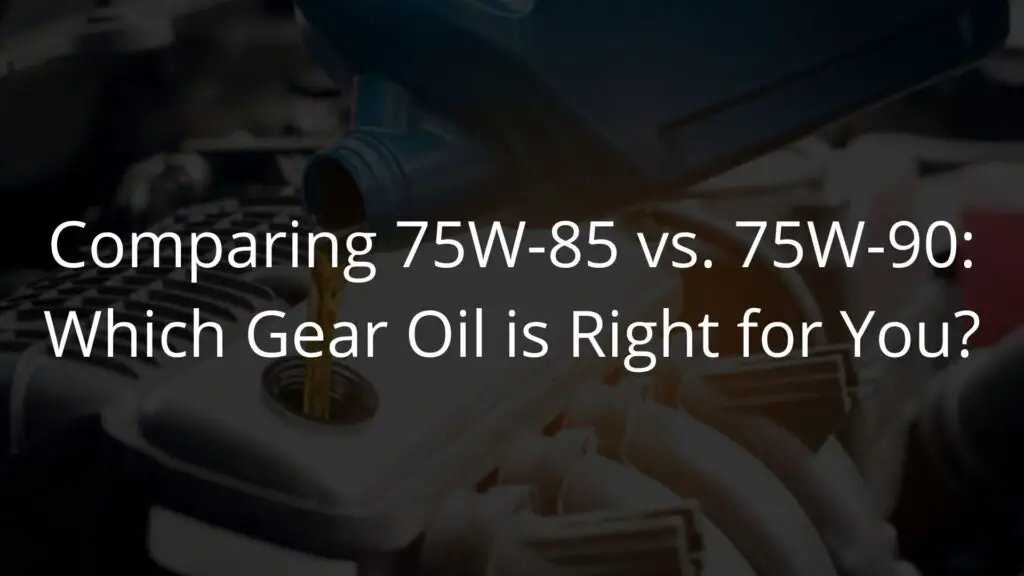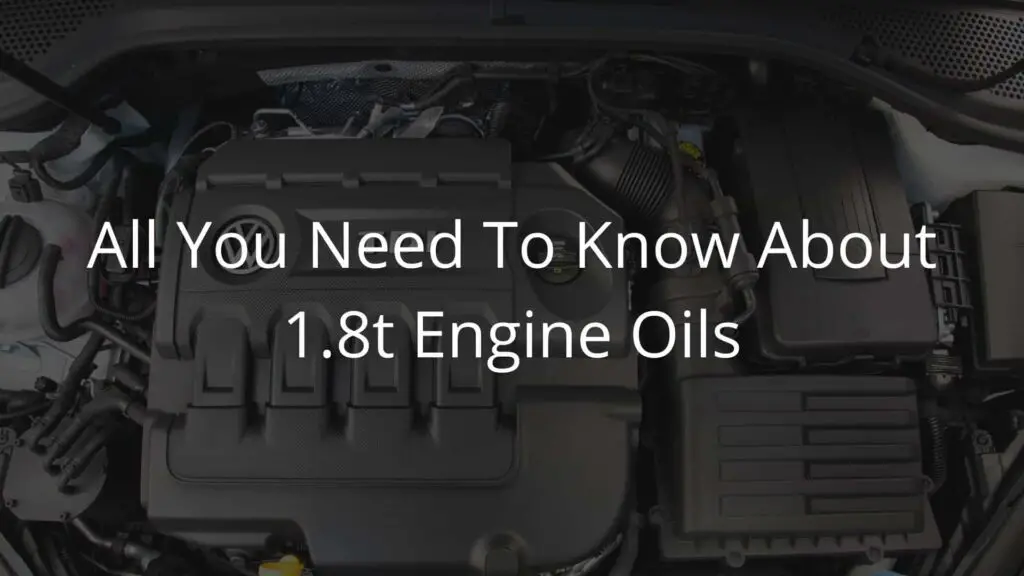When it comes to selecting the right gear oil for your vehicle or machinery, understanding the differences between 75W-85 vs. 75W-90 is crucial. These two viscosity grades can significantly impact the performance and longevity of your gear-driven systems.
In this comparison, we delve into the distinct characteristics, advantages, and applications of 75W-85 and 75W-90 gear oils, helping you make an informed decision to ensure optimal gear lubrication and protection.
- What is Gear Oil?
- What is 75W-85 Gear Oil?
- What is 75W-90 Gear Oil?
- 75W-85 vs 75W-90: Differences
- 75W-85 vs 75W-90: Similarities
- Pros and Cons of 75W-85 Gear Oil?
- Pros and Cons of 75W-90 Gear Oil?
- Factors to Choose Gear Oil
- How To Replace Gear Oil?
- Final Thoughts: Understanding the Differences — 75W-85 vs 75W-90 Gear Oil
- Frequently Asked Questions
What is Gear Oil?
Gear oil is a specialized lubricant designed for use in manual transmissions, differentials, and other gear mechanisms in vehicles and machinery. It serves several crucial functions, including reducing friction, dissipating heat, and preventing wear and tear on gear components. Over time, gear oil can become contaminated with debris and lose its effectiveness, leading to increased friction, heat, and potential damage to gears and bearings.
Regularly changing gear oil is important to maintain optimal performance, extend the lifespan of gear components, and ensure smooth and efficient operation of gears, ultimately preventing costly repairs and improving overall safety on the road or in industrial settings.
What is 75W-85 Gear Oil?
75W-85 gear oil is a type of lubricant designed for use in manual transmissions, differentials, and other gear-driven systems in vehicles and machinery. The “75W-85” designation indicates its viscosity characteristics, with the “75W” representing its low-temperature flow properties (similar to a 10W oil) and the “85” representing its high-temperature viscosity. This balanced viscosity range makes it suitable for a wide range of operating conditions.

75W-85 gear oil offers excellent protection against wear and corrosion, efficient heat dissipation, and reduced friction between gear components. It is often used in high-performance and heavy-duty applications, providing improved fuel efficiency and gear longevity while ensuring smooth gear operation.
What is 75W-90 Gear Oil?
75W-90 gear oil is a specialized lubricant designed for application in manual transmissions, differentials, and various gear-driven systems found in vehicles and machinery. The “75W-90” label signifies its viscosity characteristics. The “75W” denotes its ability to flow at low temperatures, akin to a 10W oil, making it suitable for cold start conditions. On the other hand, the “90” indicates its high-temperature viscosity, ensuring optimal lubrication and protection under extreme heat and pressure.
This gear oil excels in providing robust wear resistance, corrosion inhibition, and thermal stability, resulting in prolonged gear and bearing lifespan. Widely employed in both automotive and industrial settings, it enhances gear performance, promotes smoother gear engagement, and mitigates the risk of premature wear and equipment damage.
75W-85 vs 75W-90: Differences
| Gear Oil | 75W-85 | 75W-90 |
| Viscosity | Lower viscosity at low temps | Slightly higher viscosity at low temps |
| High-Temperature Viscosity | Lower than 75W-90 | Higher than 75W-85 |
| Cold Start Performance | Better in cold climates | Good, but not as ideal in very cold conditions |
| Usage | Typically in fuel-efficient, modern vehicles | Common in older or heavy-duty vehicles, high-stress applications |
| Protection | May provide slightly better fuel economy | Offers robust protection under heavy loads and extreme heat |
| Application | Suitable for standard conditions | Ideal for heavy-duty or high-performance applications |
| Gear Longevity | May enhance gear longevity | Can significantly extend gear and bearing life |
Here are some of the differences between 75W-85 and 75W-90
1. Flowability and Viscosity
- 75W-85 Gear Oil: It has a lower viscosity at both low and high temperatures compared to 75W-90. This means it flows more easily at cold start conditions, making it suitable for colder climates and potentially contributing to better fuel efficiency in modern vehicles.
- 75W-90 Gear Oil: 75W-90 has a slightly higher viscosity at low temperatures compared to 75W-85, making it less ideal for very cold conditions. However, it offers better protection and lubrication under high-stress and high-temperature situations.
2. Additives
- 75W-85 Gear Oil: It may contain additives optimized for fuel efficiency, resulting in reduced friction and potentially improved gas mileage. These additives may also enhance gear longevity.
- 75W-90 Gear Oil: 75W-90 gear oil typically contains additives that prioritize extreme pressure (EP) protection and durability, making it suitable for heavy-duty applications and older vehicles.
3. Compatibility
- 75W-85 Gear Oil: It is often recommended for use in modern vehicles with synchronized transmissions and limited-slip differentials. It may not be compatible with certain older or heavy-duty gear systems that require the higher viscosity of 75W-90.
- 75W-90 Gear Oil: 75W-90 is versatile and compatible with a broader range of gear systems, including older vehicles and those subjected to heavy loads or high-stress conditions.
4. Shear Resistance
- 75W-85 Gear Oil: It may have lower shear resistance compared to 75W-90 due to its lower viscosity. This could result in a gradual reduction in viscosity under high loads, potentially leading to decreased protection over time.
- 75W-90 Gear Oil: 75W-90 generally has better shear resistance, maintaining its viscosity and protection properties even under heavy loads and extreme pressure conditions.
5. Thermal Stability
- 75W-85 Gear Oil: While it provides adequate thermal stability for standard operating conditions, it may not perform as well as 75W-90 in extreme heat and heavy-duty applications.
- 75W-90 Gear Oil: 75W-90 excels in thermal stability, making it an excellent choice for gear systems exposed to high temperatures, such as heavy-duty trucks and industrial machinery.
6. Oil Change Intervals
- 75W-85 Gear Oil: Due to its lower viscosity and potential fuel efficiency additives, it might require more frequent oil changes compared to 75W-90, especially in high-stress or extreme temperature conditions. This can be a consideration for maintenance schedules and costs.
- 75W-90 Gear Oil: 75W-90 typically has longer oil change intervals, thanks to its robust protection and durability. This can be advantageous for vehicles or machinery subjected to demanding usage, as it reduces maintenance frequency.
7. Limited Slip Differential Compatibility
- 75W-85 Gear Oil: It’s often recommended for vehicles equipped with limited-slip differentials (LSD) because of its lower viscosity and potential additives tailored for LSD operation. It provides the necessary friction modification for LSDs to function optimally.
- 75W-90 Gear Oil: While 75W-90 can also be used in limited-slip differentials, it may not provide the same degree of friction modification as 75W-85. If your vehicle specifically requires LSD-compatible gear oil, 75W-85 might be the better choice.
75W-85 vs 75W-90: Similarities
| Gear Oil | 75W-85 Gear Oil | 75W-90 Gear Oil |
| Viscosity Rating | Both are multi-viscosity oils with low-temperature flow properties similar to a 10W oil. | Both are multi-viscosity oils with low-temperature flow properties similar to a 10W oil. |
| High-Temperature Viscosity | Both exhibit high-temperature viscosity akin to a 90W oil. | Both exhibit high-temperature viscosity akin to a 90W oil. |
| Gear Lubrication | Both provide effective lubrication and protection for gear components. | Both provide effective lubrication and protection for gear components. |
| Compatibility | Both are compatible with a range of manual transmissions, differentials, and gear systems. | Both are compatible with a range of manual transmissions, differentials, and gear systems. |
| Versatility | Both can be used in various automotive and industrial applications. | Both can be used in various automotive and industrial applications. |
| Base Oil | Typically, both use mineral or synthetic base oils depending on the manufacturer. | Typically, both use mineral or synthetic base oils depending on the manufacturer. |
1. Viscosity Rating
- 75W-85 Gear Oil: Both 75W-85 and 75W-90 gear oils share a similar low-temperature viscosity rating, which is equivalent to that of a 10W oil. This means they have comparable flow properties in cold start conditions.
- 75W-90 Gear Oil: Likewise, 75W-90 gear oil also boasts a low-temperature viscosity rating resembling a 10W oil, ensuring ease of flow during cold starts.
2. High-Temperature Viscosity
- 75W-85 Gear Oil: Both 75W-85 and 75W-90 gear oils exhibit high-temperature viscosity characteristics akin to a 90W oil. This ensures effective lubrication and protection of gear components under elevated temperatures and high-stress conditions.
- 75W-90 Gear Oil: Similarly, 75W-90 gear oil maintains high-temperature viscosity comparable to that of a 90W oil, ensuring consistent gear protection in extreme heat.
3. Gear Lubrication
- 75W-85 Gear Oil: Both variants excel at providing effective lubrication and protection for gear components, reducing friction and preventing wear and tear, thus extending the lifespan of gears and bearings.
- 75W-90 Gear Oil: Likewise, 75W-90 gear oil offers excellent gear lubrication, ensuring the smooth operation and longevity of gear mechanisms.
4. Compatibility
- 75W-85 Gear Oil: Both 75W-85 and 75W-90 gear oils are compatible with a wide range of manual transmissions, differentials, and gear systems commonly found in vehicles and machinery.
- 75W-90 Gear Oil: Similarly, 75W-90 gear oil is known for its versatility and compatibility, making it suitable for various automotive and industrial applications.
5.Versatility
- 75W-85 Gear Oil: Both gear oils can be used in various automotive and industrial applications, offering flexibility in their usage across different gear-driven systems.
- 75W-90 Gear Oil: Likewise, 75W-90 gear oil is versatile and adaptable, making it suitable for a broad range of gear mechanisms.
6. Base Oil
- 75W-85 Gear Oil: Typically, both 75W8-5 and 75W-90 gear oils can be formulated using either mineral or synthetic base oils, depending on the manufacturer’s specifications and performance requirements.
- 75W-90 Gear Oil: Similarly, 75W-90 gear oil can utilize mineral or synthetic base oils, ensuring compatibility with various gear systems and preferences.
7. Industry Standards
- 75W-85 Gear Oil: Both variants are designed to meet industry standards for gear lubrication and protection, ensuring that they conform to established performance and quality benchmarks.
- 75W-90 Gear Oil: Likewise, 75W-90 gear oil adheres to industry standards, guaranteeing its reliability and effectiveness in gear-driven applications.
Pros and Cons of 75W-85 Gear Oil?

Pros
- Fuel Efficiency: It may improve fuel efficiency due to its lower viscosity, reducing friction and energy losses in the transmission.
- Cold Weather Performance: Well-suited for cold start conditions, making it ideal for vehicles in colder climates.
- Limited-Slip Differential Compatibility: Often contains additives for limited-slip differentials, ensuring optimal performance in vehicles equipped with LSDs.
Cons
- Limited High-Temperature Protection: Less effective at extreme temperatures and high-stress situations compared to heavier gear oils like 75W-90, potentially leading to reduced gear and bearing lifespan.
- Compatibility Restrictions: Not suitable for all gear systems, especially heavy-duty or older vehicles that require the higher viscosity of 75W-90.
- Shorter Oil Change Intervals: May require more frequent oil changes, increasing maintenance costs in demanding conditions.
Pros and Cons of 75W-90 Gear Oil?
Pros
- High-Temperature Protection: Offers robust lubrication and protection even in extreme heat and high-stress conditions, ensuring gear and bearing longevity.
- Versatility: Compatible with a wide range of gear systems, making it suitable for both modern and older vehicles, as well as heavy-duty applications.
- Longer Oil Change Intervals: Typically requires fewer oil changes compared to lighter gear oils, reducing maintenance frequency and costs.
Cons
- Cold Weather Performance: Less ideal for very cold conditions due to its higher low-temperature viscosity, potentially affecting cold start performance.
- Limited Fuel Efficiency: May not provide the same fuel efficiency benefits as lighter gear oils like 75W-85, as it has higher viscosity and may result in increased friction and energy consumption.
- Limited LSD Additives: Some 75W-90 variants may not contain additives optimized for limited-slip differentials, requiring additional considerations for LSD-equipped vehicles.
Factors to Choose Gear Oil

Operating Conditions
Consider the temperature and stress conditions your gear system will face. For colder climates, choose a gear oil with a lower low-temperature viscosity rating, like 75W-85, to ensure smooth cold starts. In hot or high-stress environments, opt for a gear oil with a higher high-temperature viscosity rating, such as 75W-90, to provide better protection.
Vehicle or Equipment Type
The type of vehicle or machinery plays a crucial role. Modern vehicles may benefit from 75W-85 gear oil for potential fuel efficiency gains, while older or heavy-duty vehicles may require the durability and protection of 75W-90. Additionally, if your vehicle has limited-slip differentials, ensure the selected gear oil is compatible with LSDs.
Manufacturer’s Recommendations
Always consult your vehicle or equipment manufacturer’s specifications and recommendations. They often provide guidance on the appropriate gear oil viscosity, additives, and performance standards required for your specific make and model.
Usage and Maintenance
Consider how frequently you’re willing to change gear oil. Lighter gear oils like 75W-85 might require more frequent changes, impacting maintenance costs. Heavier gear oils like 75W-90 generally offer longer change intervals, reducing maintenance frequency. Evaluate your maintenance schedule and budget accordingly.
How To Replace Gear Oil?

- Gather necessary tools and safety equipment like a drain pan, socket wrench, and safety glasses.
- Locate the drain and fill plugs on the gear housing.
- Position the vehicle or machinery on a level surface.
- Remove the fill plug to allow air to flow during the draining process.
- Place the drain pan under the drain plug and carefully remove it, allowing the old gear oil to drain completely.
- Clean and inspect the drain plug before reinstalling it.
- Use a funnel to pour the appropriate amount and type of gear oil into the fill hole.
- Replace the fill plug securely.
- Check for any leaks.
- Dispose of old gear oil properly at a recycling facility.
Final Thoughts: Understanding the Differences — 75W-85 vs 75W-90 Gear Oil
In the comparison of 75W-85 vs. 75W-90 gear oils, the choice ultimately hinges on specific vehicle or machinery requirements and operating conditions. While both options offer effective gear lubrication and protection, their differences in viscosity and additives cater to distinct needs. 75W-85 excels in cold weather and fuel efficiency, whereas 75W-90 shines in high-stress and high-temperature environments.
To ensure optimal gear performance and longevity, it’s imperative to select the right gear oil that aligns with your equipment and usage scenarios, thereby maximizing efficiency and minimizing wear and tear.
For more information surrounding everything engine oils, explore our blog.



